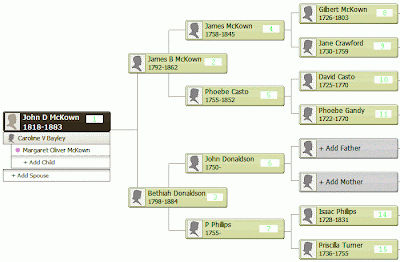Some years ago, I came up with a scheme to number ancestors, and thought it was quite original. It didn't take me long to find out it is very old, dating back to 1590, when the first Ahnentafel, or Ancestor Table, was published by Michaël Eytzinger with this numbering system, which is also known as the Eytzinger Method.
The concept of Ahnentafel Numbers is simple, and is based on the fact that each generation you go back, you have twice as many ancestors as in the prior one: two parents, four grandparents, eight great grandparents, and so forth. If you make a pedigree chart in the ordinary way, with the father shown on the line above the mother in each couple, then you number this way:
- Your number, as the root of the table, is 1.
- Your father's number is 2 and your mother's is 3.
- Your father's parents are numbered 4 and 5, while your mother's parents are numbered 6 and 7.
- The next generation gets numbered from 8 to 15; and so it goes.
Before reading further, click on the chart below (clipped from Ancestry.com) to see the full-size image, so you can more easily read the green numbers next to the names.

This is a small Ahnentafel for John D. McCown, an ancestor of mine. Note that two ancestors are not known. The numbers 12 and 13 belong to those two slots, so if some day I find out who they were, they get those numbers, which are reserved for them.
In my own Ahnentafel charts, John D. McKown is numbered 42, so the male succession of this chart continues 84 for James B., 168 for James, and 336 for Gilbert McKown. Priscilla Turner at the bottom right is then numbered 343. (She and her husband are descended from Mayflower families, so information about them has been easy to find.)
If you have a calculator that can convert decimal numbers to binary, you can determine the father-mother sequence that leads to an ancestor when you know the person's Ahnentafel Number. For John D. McKown, 42 is 32+8+2, or 101010. I am the first 1, my father is the second digit, a 0 (because it is even), his mother is next, then her father, then his mother, then the last father, John D. Or, to be short, John D. McKown is my father's mother's father's mother's father.
I have very few quibbles with Ancestry.com, but one of them is that I wish I could print a pedigree that included the Ahnentafel numbers. I've been adding them by hand to the pedigree sheets I print. Since I know one line of ancestors going back 24 generations, some of those numbers have eight digits! Though numbers that big are unwieldy, most of my pedigree has numbers of four digits and fewer. They are a great help for bookkeeping. See this Wikipedia article for a detailed explanation of Ahnentafel Numbers.



No comments:
Post a Comment